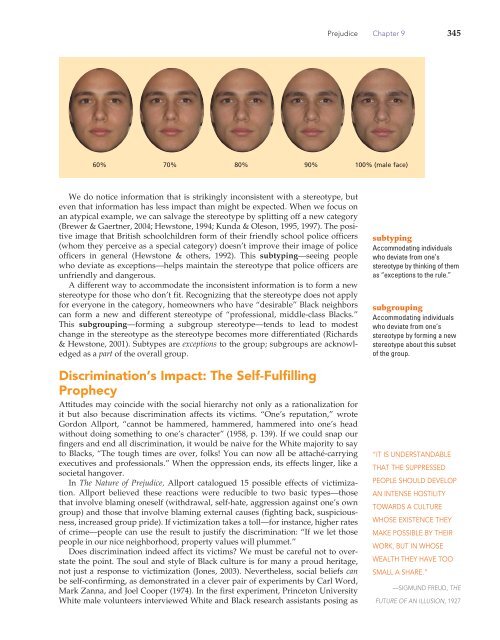Chapter 9: Prejudice: Disliking Others (2947.0K) - Bad Request
Chapter 9: Prejudice: Disliking Others (2947.0K) - Bad Request
Chapter 9: Prejudice: Disliking Others (2947.0K) - Bad Request
Create successful ePaper yourself
Turn your PDF publications into a flip-book with our unique Google optimized e-Paper software.
<strong>Prejudice</strong> <strong>Chapter</strong> 9 345<br />
60% 70% 80% 90% 100% (male face)<br />
We do notice information that is strikingly inconsistent with a stereotype, but<br />
even that information has less impact than might be expected. When we focus on<br />
an atypical example, we can salvage the stereotype by splitting off a new category<br />
(Brewer & Gaertner, 2004; Hewstone, 1994; Kunda & Oleson, 1995, 1997). The positive<br />
image that British schoolchildren form of their friendly school police officers<br />
(whom they perceive as a special category) doesn’t improve their image of police<br />
officers in general (Hewstone & others, 1992). This subtyping —seeing people<br />
who deviate as exceptions—helps maintain the stereotype that police officers are<br />
unfriendly and dangerous.<br />
A different way to accommodate the inconsistent information is to form a new<br />
stereotype for those who don’t fit. Recognizing that the stereotype does not apply<br />
for everyone in the category, homeowners who have “desirable” Black neighbors<br />
can form a new and different stereotype of “professional, middle-class Blacks.”<br />
This subgrouping —forming a subgroup stereotype—tends to lead to modest<br />
change in the stereotype as the stereotype becomes more differentiated (Richards<br />
& Hewstone, 2001). Subtypes are exceptions to the group; subgroups are acknowledged<br />
as a part of the overall group.<br />
Discrimination’s Impact: The Self-Fulfilling<br />
Prophecy<br />
Attitudes may coincide with the social hierarchy not only as a rationalization for<br />
it but also because discrimination affects its victims. “One’s reputation,” wrote<br />
Gordon Allport, “cannot be hammered, hammered, hammered into one’s head<br />
without doing something to one’s character” (1958, p. 139). If we could snap our<br />
fingers and end all discrimination, it would be naive for the White majority to say<br />
to Blacks, “The tough times are over, folks! You can now all be attaché-carrying<br />
executives and professionals.” When the oppression ends, its effects linger, like a<br />
societal hangover.<br />
In The Nature of <strong>Prejudice</strong>, Allport catalogued 15 possible effects of victimization.<br />
Allport believed these reactions were reducible to two basic types—those<br />
that involve blaming oneself (withdrawal, self-hate, aggression against one’s own<br />
group) and those that involve blaming external causes (fighting back, suspiciousness,<br />
increased group pride). If victimization takes a toll—for instance, higher rates<br />
of crime—people can use the result to justify the discrimination: “If we let those<br />
people in our nice neighborhood, property values will plummet.”<br />
Does discrimination indeed affect its victims? We must be careful not to overstate<br />
the point. The soul and style of Black culture is for many a proud heritage,<br />
not just a response to victimization (Jones, 2003). Nevertheless, social beliefs can<br />
be self-confirming, as demonstrated in a clever pair of experiments by Carl Word,<br />
Mark Zanna, and Joel Cooper (1974). In the first experiment, Princeton University<br />
White male volunteers interviewed White and Black research assistants posing as<br />
subtyping<br />
Accommodating individuals<br />
who deviate from one’s<br />
stereotype by thinking of them<br />
as “exceptions to the rule.”<br />
subgrouping<br />
Accommodating individuals<br />
who deviate from one’s<br />
stereotype by forming a new<br />
stereotype about this subset<br />
of the group.<br />
“IT IS UNDERSTANDABLE<br />
THAT THE SUPPRESSED<br />
PEOPLE SHOULD DEVELOP<br />
AN INTENSE HOSTILITY<br />
TOWARDS A CULTURE<br />
WHOSE EXISTENCE THEY<br />
MAKE POSSIBLE BY THEIR<br />
WORK, BUT IN WHOSE<br />
WEALTH THEY HAVE TOO<br />
SMALL A SHARE.”<br />
—SIGMUND FREUD, THE<br />
FUTURE OF AN ILLUSION, 1927

















